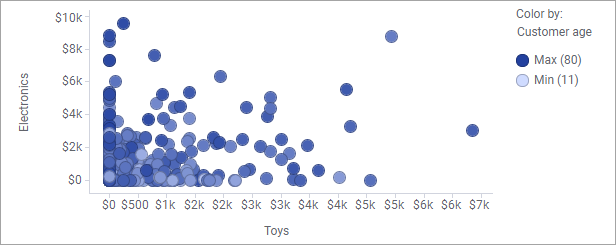By adding color rules, you can let the colors of specified items
deviate from the ordinary coloring of the visualization items.
About this task
A color rule
contains a condition and a color. All visualization items that fulfill the
condition get the color you have specified. For example, you can add rules that
let the top values, or values in a specified interval, stand out in a certain
color. See some examples in
Working
with colors.
To specify conditions, different rule types are predefined. Which rule
types are available depends on whether the column that is selected on the
Color by axis contains categorical values or
numerical values.
More than one color rule can be added to a visualization.
Procedure
-
In the visualization properties dialog or popover, locate the
Colors or
Color section. In the visualization properties
panel, add or expand the
Color by section.
-
Make sure the column you want to color by is selected on the
Color by axis.
-
Click
Add rule or
Add color rule depending on which client you
use.
In the visualization properties panel, a first assumption of a
rule is added directly. Edit the
custom expression or click
 to select a different rule
type.
to select a different rule
type.
If you add the rule from the visualization properties dialog or
popover, a dialog opens. It looks slightly different depending on the client
you use, but the same functionality is available. The dialog provides different
rule types depending on whether the selected column on the
Color by axis contains categorical values or
numerical values. For details on the rule types, see
Add/edit rule.
-
Select a
Rule type in the drop-down menu.
Different rule types require different inputs such as fixed
values that you type, aggregations selected from the drop-down menu, or custom
expressions. For example, in a
Top rule, the input is how many top values
should stand out.
-
In the dialog, specify the needed input in the field below
Rule type by using the drop-down menu or by
entering a value. In the visualization properties panel, this input is
specified directly in the expression.
-
Click the
Color selector to open a palette and select
which color to use for the items fulfilling the rule.
-
Optionally, type a
Display name for the added rule in the field.
In the visualization properties panel, you can specify a display name by using
the
as expression. For example, the expression
NthLargest([Axis.Color],5)<=[Axis.Color] as [Top
5] is shown in the legend as Top 5.
The display name is shown in the legend. If you leave the
field empty, the default rule type name is shown.
-
Click
OK.
Results
The color rule is
applied to the visualization, and the added rule is shown on the Colors/Color
section. To remove the rule, click the X to the right.
The images below show how the same three rules will look in the
Colors section of the visualization properties dialog and panel respectively.


If the legend is visible, you can see all the applied rules in the
legend as well.
Note: More than one color
rule can be added to a visualization. The most recent color rule is added at
the top, but you can change the order of the color rules. The order of the
rules is important, because the rules are prioritized from top to bottom. See
below for an example of rule priority.
Changing the order of the rules
To change the order of color rules in a visualization, open the
visualization properties dialog or popover depending on which client you use,
and locate the Color/Colors section. You can then click and drag the rule to
the new position. In the visualization properties panel, click to the left of
the rule to drag it.


Example of a color
rule
In the scatter plot below, the markers represent how much money each
customer spent at the electronics and toys departments in a store. The gradient
coloring of the marker indicates the age of the customers.
Assume you want to examine the buying behavior among the oldest
customers. By adding the
Top color rule with 25 as input value, the
markers representing the 25 oldest customers are distinguished.
Note: In the
scatter plot above, also the
Drawing order is specified to Customer age to draw the
lowest values first in the plot, and the highest values last. This means all
the markers of interest in this particular example are drawn on top of the
others, and therefore not hidden behind others.
Tip: Color
rules can be part of
predefined color schemes. For example, the
Top rule used above is in fact the
Top n color scheme. The default n value in the
color scheme is 10, but has been changed to 25 in this case.
Example of rule
priority
The order of the rules, which can be viewed in the legend, is
important, because the rules are prioritized from top to bottom.
The bar charts below show the sales of different fruits and
vegetables. In both the charts, two color rules are added. One color rule is
defined to show the two highest bars in yellow, and the other color rule to
show bars between 700 and 900 in red. Note the different orders of the color
rules, and the different coloring.
One bar, 'Pears', fulfills the conditions in both the rules. However,
in the first bar chart, the 'Top 2 rule' overrides the 'Between 700 and 900'
rule, and in the second bar chart, the opposite priority is applied.
Note: If a color rule does
not have any effect on the visualization, it is not listed in the legend.







